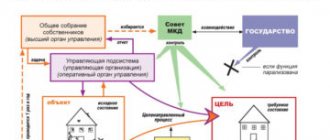What is a production cooperative
IMPORTANT! The form of the Charter of an agricultural production cooperative from ConsultantPlus is available here
A production cooperative (PC, alternative name - artel) is an association of participants on a voluntary basis to conduct production, trade or other activities. As a rule, each party makes a share contribution.
An alternative to making a physical contribution is to work for the benefit of the association. Participants can be both individuals and legal entities. In the latter case, the participation of the legal entity must be recorded in the constituent documentation.
Question: How can I make changes to the information about the participants of a production cooperative in the Unified State Register of Legal Entities? View answer
Normative base
There is a Federal Law “On Production Cooperatives” dated 05/08/1996 N 41. It regulates the following aspects:
- PC education.
- Activity.
- Shutdown.
The law regulates artels engaged in such activities as:
- Production of products.
- Implementation.
- Construction of facilities.
- Various services.
- Mining.
- Working with secondary raw materials.
- Marketing, medical services and more.
The regulations governing activities depend on what exactly the cooperative does. For example, the activities of agricultural entities are regulated by Federal Law No. 198 of December 27, 2005.
Question: The production cooperative has been declared bankrupt. Is it possible to impose subsidiary liability solely on the chairman of the cooperative and the board if the charter does not regulate this issue? View answer
The rules regarding production cooperatives are contained in the Civil Code of the Russian Federation. General provisions can be found in Articles 106.1-106.6. The definition of a production cooperative is specified in paragraph 1 of Article 50 of the Civil Code of the Russian Federation. This is a commercial association whose main goal is to make a profit. More detailed instructions are contained in Federal Law No. 41.
FOR YOUR INFORMATION! The form in question differs from consumer cooperatives. The latter are non-profit associations.
Basic aspects of simplified accounting
A production cooperative may belong to the corresponding category of business entities - SMP. According to Federal Law No. 402 (December 6, 2011), which regulates accounting in organizations, such an entity is obliged to record transactions of financial and economic activities and has the right to maintain simplified accounting. That is, a small manufacturing enterprise can conduct accounting in a general manner or use a simplified algorithm. The corresponding decision is made by management.
Important: you can use the right to maintain simplified accounting only if the enterprise meets the SMP criteria specified in Federal Law No. 209 of July 24, 2007 (as amended). These include, for example, a certain total share of participation of the state, funds and legal entities that are not SMPs in the authorized capital.
The status of a small business entity may become unavailable if the cooperative does not meet the criteria specified in the mentioned law and exceeds the threshold of the average number of employees. The latter for medium-sized companies is limited to the range of 1010-250 people, for small enterprises - 16-100 people, for micro-enterprises - 1-15 people.
Main features
Production characteristics meet the following criteria:
- Joining is on a voluntary basis.
- Each participant has the right to a part of the association.
- Each participant has the right to vote at the meeting, which allows them to take part in decision-making regarding the cooperative.
- A cooperative is formed for a specific activity.
- Each participant must make a contribution either in material form or in the form of personal participation.
If an association does not meet the listed characteristics, it cannot be considered a production cooperative.
Advantages and disadvantages
A production cooperative has the following advantages:
- Distribution of profits between participants depending on their contribution to the association. In a similar way, assets are distributed after the liquidation of an artel. This approach motivates participants to improve and increase their labor contribution.
- Any number of participants can join an artel. There are no restrictions.
- Participants are given equal rights. Each party has equal authority to manage the association.
- Each participant has the right to sell his share. That is, your share can be easily converted into cash.
- Quickly achieve your goals by combining the resources of all participants.
Artel is characterized by the following disadvantages:
- If the cooperative incurs a large debt, all participants bear responsibility for it.
- A person is responsible for debts with personal property. The liability of a participant is limited to the size of his share.
- Activities are carried out jointly. All participants will have to bear responsibility for the wrong decisions made by others.
All the advantages and disadvantages of a production cooperative are relative. That is, with proper organization of activities, the artel will not suffer from characteristic disadvantages. If the production cooperative operates illiterately, you can forget about the characteristic advantages. Significant shortcomings of the artel appear only when a large debt has accumulated.
Blog
Activities are regulated by the Civil Code of the Russian Federation, No. 41-FZ dated 05/08/1996 “On production cooperatives”.
A production cooperative is a voluntary association of citizens on the basis of membership for joint production or other economic activities (production, processing, sales of products, performance of work, trade, consumer services, provision of other services), based on their personal labor and other participation and association by its members ( participants) property share contributions.
PC is a commercial organization and can be based on any taxation system.
The minimum number of PC members is at least five people. The maximum number of PC members has not been established.
PC members:
those who take personal labor participation in the activities of the cooperative; those who do not take personal labor participation in the activities of the cooperative. They should not be more than 25% of the number of cooperative members included in the first group.
A cooperative may employ employees who are not members of the cooperative. Their number cannot exceed 30% of the number of PC members.
Related course
Accounting and tax accounting for managers
Find out more
A PC member contributes his ability to work. Employment contracts are not drawn up with PC members.
Relations are regulated by the cooperative's charter and internal regulations.
Profit is distributed among PC members in accordance with their personal and (or) other participation and the size of the share contribution. No more than 50% of the total profit of the PC can be distributed in proportion to the size of the share contribution.
Members of the PC are subject to social and compulsory health insurance and social security on the same basis as hired employees of the cooperative.
The time spent working in a PC is included in the length of service, and a record of membership in the cooperative is made in the work book.
Two payment options
labor of PC members:
1) payment for labor in cash and (or) in kind. This is a salary that is subject to personal income tax and insurance contributions in the generally established manner.
Total
taxation: 13% personal income tax + 20 (30)% insurance premiums.
2) part of the PC’s profit:
2.1) in proportion to the size of the share contribution (no more than 50% of profit)
Paid from net profit, not subject to insurance premiums. The personal income tax rate is 13%. Similar in nature to dividend payments.
Total
: income tax for a cooperative: OSNO profit 20%, simplified tax system 6% or 15% + 13% NFDL.
2.2) in accordance with the personal labor participation of a member of the cooperative.
Payments are considered as wages (since 2015).
There is a lot of controversy over “labor functions”. We recommend that it be reflected in the Charter that members of the cooperative do not receive wages for their work, but receive dividends in the monthly distribution of profits depending on their labor participation, which is determined by the Charter.
When determining the order of profit distribution in accordance with labor participation, one cannot refer to the labor process. It is necessary to focus on the result of labor, that is, on the labor contribution to the profit received by the cooperative.
For production employees, it is recommended to develop a point system, based on the planned and actual volume of production per each member of the cooperative, the use of reducing factors, for example, in the presence of “defects,” etc.
There should not be documents that are typical for labor relations: staffing schedule, tariff and qualification characteristics of work, job descriptions, orders for appointment to a position and other documents indicating a specific profession, specialty, type of work assigned. An analogue of the staffing table can be “a list of cooperative members who take personal labor participation in the activities of the cooperative.” An analogue of an order is the protocol of a meeting of members of the PC and the order of the Chairman of the PC, acting in accordance with the Charter.
The composition of the members of the cooperative should not include employees whose functionality does not directly affect the generation of profit, for example, an accountant, lawyer, service personnel, etc. It is better to conclude employment contracts with them or outsource them.
If it is necessary to conclude an employment contract with a member of the cooperative, then it is necessary to separate the function for which he will receive a salary from his work as a member of the cooperative.
There are a lot of controversial issues on this topic. On the part of the Federal Tax Service, the creation of a PC from its employees is a tax scheme (with a high degree of probability). There are also disputes regarding the taxation (non-taxation) of payments with insurance premiums. Lawmakers don't have a clear answer.
Accounting encyclopedia "ProfRosta"
03.11.2017
Information on the page is searched for by the following queries: Accountant courses in Krasnoyarsk, Accounting courses in Krasnoyarsk, Accountant courses for beginners, 1C: Accounting courses, Distance learning, Accountant training, Training courses Salaries and personnel, Advanced training for accountants, Accounting for beginners Accounting services, VAT declaration, Profit declaration, Accounting, Tax reporting, Accounting services Krasnoyarsk, Internal audit, OSN reporting, Statistics reporting, Pension Fund reporting, Accounting services, Outsourcing, UTII reporting, Bookkeeping, Accounting support, Provision of accounting services services, Assistance to an accountant, Reporting via the Internet, Drawing up declarations, Need an accountant, Accounting policy, Registration of individual entrepreneurs and LLCs, Individual entrepreneur taxes, 3-NDFL, Accounting organization
Controls
The PC must include at least five participants. Parties to the artel can be people with foreign citizenship or no citizenship at all. The main governing body is the general meeting of participants. Executive bodies may be formed at the general meeting. The board and chairmen may act in their capacity. Functions of executive bodies:
- Management of a production cooperative.
- Making decisions within your competence.
Executive bodies cannot make a number of key decisions. This is the sole responsibility of the participants in the general meeting. At any time, the elected executive body may be deprived of its powers.
Cooperative members
Artel participants bear subsidiary liability. That is, the larger a person’s contribution, the more profit he can receive. At the same time, a great contribution implies a great responsibility. For example, the artel has a large debt. Liability for it can be compensated by participants at the expense of their personal property. However, the limits of liability are limited by the size of the contribution. If a person's contribution is large, he receives large profits. But if you have debts, you will have to answer for the debts with your property to the appropriate extent.
IMPORTANT! The liability of a legal entity is similar to the liability of a sole proprietor.
Constituent documentation
The main document on the basis of which the artel operates is the charter. All its provisions must comply with the law. Based on the charter, orders and other documents necessary for conducting activities are created.
Procedure for establishing an association
The procedure for creating production cooperatives is enshrined in Article 2 of the Civil Code of the Russian Federation. The composition and number of participants in the association is determined by Federal Law No. 41-FZ dated 05/08/1996. The initial number of shareholders when establishing a cooperative is 5 people. Participants in the association can be residents of Russia, foreign entities and stateless persons. Also, enterprises and citizens engaged in running personal subsidiary plots can participate in the economic activities of the association (Article 13 of the Federal Law of December 8, 1995 No. 193-FZ). For this purpose, the organization appoints its representative. He acts on the basis of a power of attorney.
The law provides for membership even in the absence of labor relations with the organization. The number of members of the association should not exceed 25% of all participants.
The creation of a production cooperative consists of several stages. Initial stage:
- future members of the association decide to establish an organizing committee;
- the formed body is engaged in the economic justification of the start-up capital, determining the amount of share contributions, developing the charter, accepting applications, and preparing for the next meeting.
General meeting
The creation of a production cooperative begins with a meeting. A chairman and secretary are elected from the meeting participants. The chairman conducts the meeting, and the secretary displays the results of the votes in the minutes of the meeting. Purpose of the general meeting:
- approval of the charter;
- election of governing bodies;
- acceptance of new members into the association.
Sample protocol for creating a production cooperative:
The protocol for the creation of a production cooperative is sealed with the signatures of the chairman and secretary. The document is required when registering an association.
Contents of the charter
The charter of the production association must contain the following points:
- name of company;
- location of the association (city, village);
- the amount of the share contribution, the procedure for depositing funds, liability for non-compliance with the requirements of the charter;
- the basics of labor participation in the activities of the association;
- distribution of income/expenses;
- subsidiary obligations;
- structure of management bodies, their powers, decision-making procedure;
- a mechanism for paying profits to citizens who left the cooperative;
- procedure for accepting new participants;
- rules for leaving/expulsion from the organization;
- the procedure for forming the property of the association;
- information about representative offices/branches;
- rules for transformation/termination of community activities.
Failure to comply with these requirements is grounds for refusal of state registration of the cooperative.
Registration procedure
The association begins to exist from the moment the relevant information is entered into the Unified State Register of Legal Entities. The registration procedure is established by Federal Law No. 129-FZ dated 08.08.2001. A legally significant action is carried out at the place of its actual location. The application is submitted to the territorial branch of the Federal Tax Service. List of required documents:
- minutes of the meeting (when creating a production cooperative, each participant is required to sign it);
- charter of the association (with signatures of participants);
- application for registration of a legal entity certified by a notary. The applicant is the chairman of the cooperative;
- receipt of payment of state duty.
Documents can be submitted in one of the following ways:
- personally;
- through a multifunctional center (MFC);
- send a letter with a description of the attachment;
- via the Internet (State Services, Federal Tax Service website).
When applying to the Federal Tax Service in person, only the applicant or a representative by proxy can receive documents.
Registration of the association is carried out within three days from the date of submission of documents. The reason for refusal may be inaccuracies in the application or the name of the cooperative. For example, if it is against the law.
Authorized capital
The minimum amount of the association's authorized capital is not established by regulations - it is determined by the participants themselves. The share is contributed both in assets and in cash. If a participant contributes property to the association in an amount exceeding 25,000 rubles, an independent assessment of the assets is first carried out.
The main requirement regarding the capital of the artel is that each party contributes at least 10% of its share before the date of official registration of the association. Before registering a cooperative, participants must resolve the following issues:
- Amount of authorized capital.
- Raising funds in an amount of at least 10% of the established amount of the authorized capital.
The remaining amount must be paid within a year from the date of registration.
Constituent documents of cooperatives
The list of the most important forms of non-profit organizations provided for by the Civil Code and the Law “On Non-Profit Organizations” includes consumer cooperatives, public and religious organizations (associations), foundations, non-profit partnerships, institutions, autonomous non-profit organizations, associations of legal entities (associations and unions).
A cooperative is a voluntary association of citizens and legal entities with the aim of satisfying the material and other needs of the participants. The creation of a cooperative is carried out on the basis of combining the property share contributions of the participants. Cooperatives are widespread in our country. These are, for example, garages, dacha cooperatives, etc.
The cooperative is created on the basis of the charter, which is its only constituent document. In addition to the general information necessary for the constituent documents of any legal entity, the charter of the cooperative must also contain the following information:
- full and abbreviated corporate names of the cooperative
- location;
- type of cooperative;
- size of the authorized capital;
- the structure and competence of management bodies and the procedure for their decision-making;
- the procedure for preparing and holding a general meeting, including a list of issues on which decisions are made by the governing bodies by a qualified majority of votes or unanimously
- on the amount and procedure for making share contributions by members of the cooperative;
- about the nature and procedure of their labor participation in its activities;
- on the amount and conditions of subsidiary liability of its members for the debts of the cooperative and some others (clauses 1 and 2 of Article 108 of the Civil Code; Article 5 of the Law on Production Cooperatives).
The charter may contain other provisions that do not contradict the legislation of the Russian Federation.
At the request of any interested person, the cooperative is obliged, within a reasonable time, to provide them with the opportunity to familiarize themselves with the charter, including changes and additions to it. The cooperative is obliged to provide a member of the cooperative, upon his request, with a copy of the current charter.
Amendments and additions to the charter or approval of the charter in a new edition are carried out by decision of the general meeting. Amendments to the charter related to the reduction of the authorized capital are carried out on the basis of a decision to reduce the authorized capital adopted by the general meeting.
The charter specifies the conditions for share contributions of members of the cooperative, a provision on the procedure for making share contributions by members of the cooperative and their responsibility for violating obligations to make share contributions, the nature and procedure for the labor participation of members of the cooperative in its activities and their responsibility for violating the obligation for personal labor participation, on the procedure for distributing profits and losses of the cooperative, on the amount and conditions of subsidiary liability of its members for the debts of the cooperative, on the composition and competence of the management bodies of the cooperative and the procedure for their decision-making, including on issues requiring a unanimous or qualified majority of votes. The amount and procedure for the responsibility of members of the cooperative for its obligations is also provided for in the charter. A member of a cooperative has the right to leave the cooperative at his own discretion. In this case, at the end of the financial year, he must be paid the value of the share or given property corresponding to his share, as well as other payments provided for by the charter of the cooperative. An interesting feature of cooperatives is that its constituent documents may provide for the participation of legal entities in the activities of the cooperative. The form of such participation is collective membership.
The procedure for liquidating a cooperative
Let's consider the stages of liquidation of an artel:
- Collection of liquidation documents. Organization of an extraordinary meeting of participants at which the decision on liquidation is announced. At the same meeting, an action plan is formed and members of the liquidation commission are selected.
- Sending a notice to the tax authorities. After this, adjustments are made to the Unified State Register.
- Local media publishes information about the liquidation. At the same time, the address of the liquidation commission is indicated so that those interested can ask questions.
- If creditors have not made any claims, an interim liquidation balance sheet must be created, which is approved at the meeting.
- An inventory act for the association's property is drawn up.
- If the association is unable to cover its debts to creditors, the artel’s property is sold at auction.
- After all debts have been repaid, a final balance sheet is formed, which must be approved at the meeting.
- An entry about liquidation is made in the Unified State Register of Legal Entities.
The existence of an association can be terminated through reorganization.






